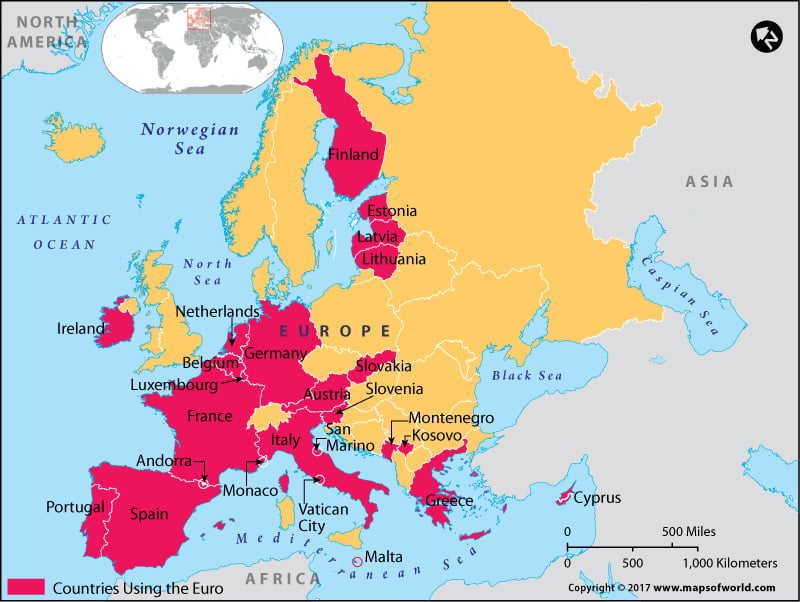What Countries use the Euro?

The Euro is the official currency of the European Union. It is, however, not incumbent upon the members of the European Union to use the Euro. In this article, we will learn what countries use the Euro?, how many and more.
How Many Countries Use the Euro?
There are a total of 26 countries that use the Euro as their currency of exchange.
What are the Countries that Use Euro?
Eurozone usually refers to the 20 EU member nations of 27 EU members, which use the Euro as legal tender. Apart from the member nations, two non-EU countries Kosovo and Montenegro also use the Euro. Four very small states-(micro-states)- Andorra, Monaco, San Marino, and Vatican City also use the Euro.
Here is a list of the countries that use the Euro along with the date they adopted it:
- Austria – January 1, 1999
- Belgium – January 1, 1999
- Finland – January 1, 1999
- France – January 1, 1999
- Germany – January 1, 1999
- Ireland – January 1, 1999
- Italy – January 1, 1999
- Luxembourg – January 1, 1999
- Netherlands – January 1, 1999
- Portugal – January 1, 1999
- Spain – January 1, 1999
- Greece – January 1, 2001
- Slovenia – January 1, 2007
- Cyprus – January 1, 2008
- Malta – January 1, 2008
- Slovakia – January 1, 2009
- Estonia – January 1, 2011
- Latvia – January 1, 2014
- Lithuania – January 1, 2015
- Croatia – January 1, 2023
Denmark (currency-Danish Krone) and Sweden (currency Swedish Krone), though members of the EU, do not use the Euro.
Countries in the Process to Use the Euro
Several countries are getting ready to use the Euro, a status known as being in the “Eurozone waiting room.” They need to meet certain economic and legal conditions before they can start using the Euro. These countries include:
- Bulgaria: Bulgaria is working on joining the Eurozone and plans to use the Euro soon.
- Romania: Romania is also preparing to adopt the Euro, but there is no specific date set yet.
- Hungary: Hungary wants to use the Euro, but it hasn’t met all the necessary conditions yet.
- Poland: Poland plans to adopt the Euro eventually, but there is no set timeline.
- Czech Republic: The Czech Republic intends to use the Euro, but progress has been slow.
Importance of the Euro in the Worldwide
- Economic Stability: The Euro helps keep the economy stable in the Eurozone by getting rid of the need to exchange money between member countries. This makes the economy more predictable and reliable.
- Ease of Trade: Using the same currency makes it easier and cheaper for businesses to trade with each other across different countries in the Eurozone. They don’t have to exchange money, which cuts costs and makes transactions simpler.
- Price Transparency: Using the same currency makes it easy to compare prices across different countries. This encourages competition and helps consumers get better prices and more choices.
- Global Influence: The Euro is the second most commonly held currency in the world after the US dollar. This gives the Eurozone a lot of power in global financial markets and international trade.
- Investment Attraction: When a currency like the Euro is stable and strong, it can draw investments from countries outside the Eurozone. This helps boost economic growth and development.
- Political Integration: The Euro is an important symbol of European countries working together more closely. It helps create a feeling of unity and cooperation among these countries.
- Economic Resilience: Because the Eurozone is a big group of economies working together, it can handle economic problems and crises better than smaller countries can on their own. This makes it more resilient against tough economic situations.
- Tourism and Travel: When people travel within the Eurozone, using the same currency in different countries makes it easier. They don’t have to worry about exchanging money, which makes spending and travel simpler and less complicated.
Interesting Facts about Euro
- The Euro banknotes and coins show different styles of buildings from Europe’s history. This is meant to represent how European countries are united and work together.
- Euro banknotes look the same in all Eurozone countries. One side shows windows and gates, and the other side shows bridges.
- The Euro’s official currency code is EUR, which comes from the Greek word “Ευρώ,” meaning “Europe.”
- Every Euro coin has one side that shows its value, but the other side can be different in each country. These designs often reflect the culture and history of that country.
Related Links